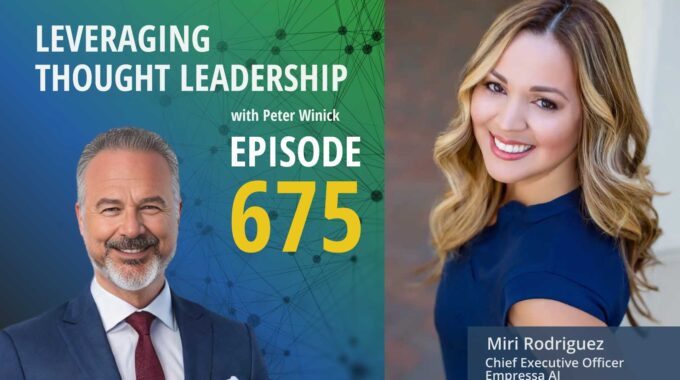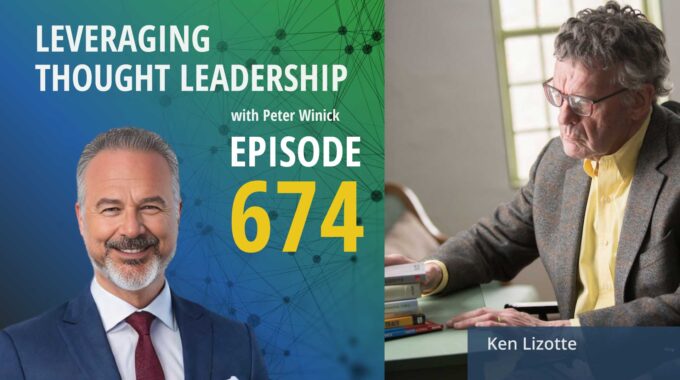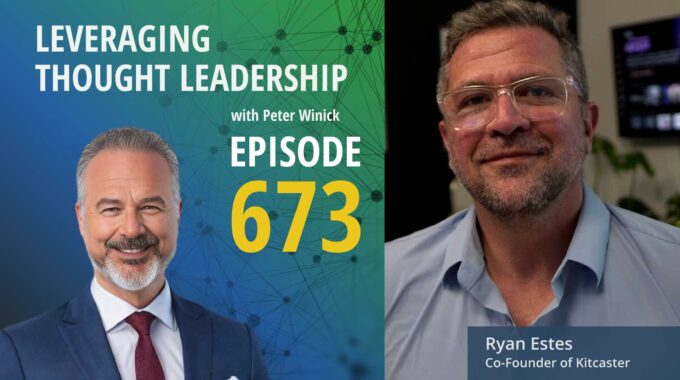The leadership advantage of acting with clarity, confidence, and purpose. This episode explores how leaders…
The Innovative Leader: Building Systems for Lasting Innovation | Steve Wunker
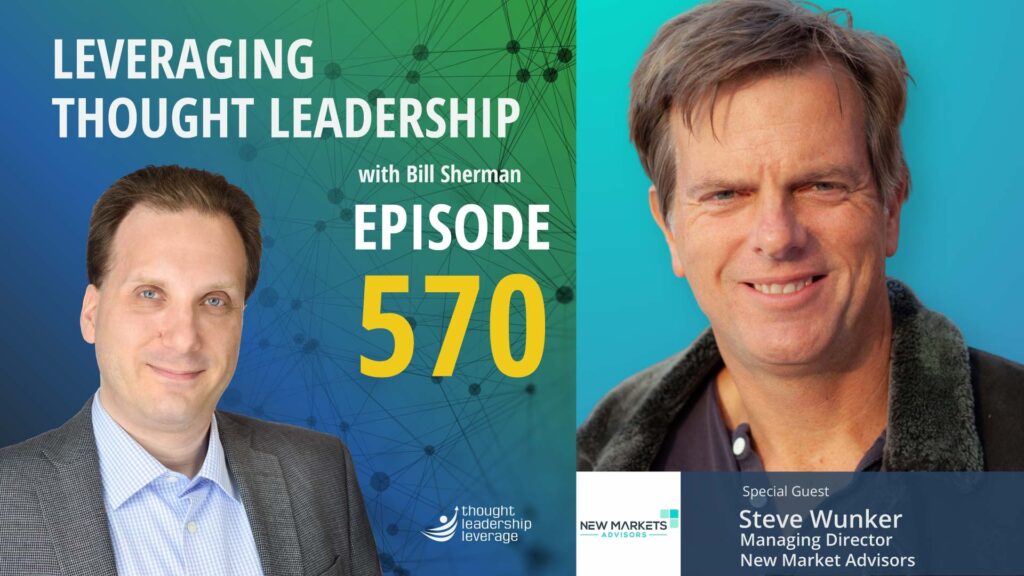
Actionable Steps for Leaders to Drive Innovation in Organizations
A conversation with Steve Wunker about his approach to making innovation a system that is actionable to individuals, teams, and organizations.
In this episode of Leveraging Thought Leadership, host Bill Sherman engages with Steve Wunker, Managing Director of New Market Advisors and co-author of the groundbreaking book The Innovative Leader: Step-By-Step Lessons from Top Innovators for You and Your Organization. Join them as they delve into the intricacies of fostering innovation within organizations and cultivating innovative leadership.
Steve Wunker shares the core essence of The Innovative Leader, emphasizing its focus on the practical “how” of innovation. Drawing from interviews with 50 top innovative leaders and two decades of professional experience, the book provides actionable insights for individuals and organizations aiming to embrace innovation effectively.
Delving into the genesis of the book, Wunker explains the rationale behind merging leadership and innovation, bridging a crucial gap in existing literature. He recounts his journey collaborating with luminaries like Clayton Christensen and Fred Reichheld, emphasizing the transformative power of distilling complex concepts into compelling narratives.
The Innovative Leader isn’t just another book; it’s a culmination of rigorous research and inductive conversations aimed at demystifying innovation. Wunker sheds light on the book’s data-driven approach, underscored by the belief that innovation is fundamentally about systems rather than sporadic bursts of inspiration.
As they explore the strategies for book promotion, Wunker emphasizes the importance of striking a balance between broad outreach and deep engagement. From social media blitzes to keynote speeches and immersive articles, the book’s marketing campaign is meticulously crafted to resonate with diverse audiences.
Looking ahead, Wunker envisions The Innovative Leader as a seminal work shaping the landscape of innovative leadership for years to come. With aspirations for it to become a staple on the shelves of aspiring and seasoned leaders alike, Wunker underscores the importance of continuous engagement and dissemination across various platforms.
Tune in to this episode for invaluable insights into building a culture of innovation and unlocking the potential of leadership in driving meaningful change within organizations.
Three Key Takeaways:
Innovation is Systematic: The episode emphasizes that innovation isn’t merely a stroke of luck or genius but a systematic process. By understanding and implementing effective systems, individuals and organizations can foster a culture of innovation and sustain it over time.
Practical Actionability: The Innovative Leader stands out for its emphasis on practicality and actionability. It fills the gap in existing literature by providing step-by-step guidance for leaders and managers who aspire to drive innovation within their organizations, offering tangible strategies derived from real-world experiences.
Comprehensive Marketing Strategy: Wunker highlights the significance of a comprehensive marketing strategy for launching a book successfully. By combining broad outreach through platforms like social media with deep engagement via keynote speeches, articles, and podcasts, authors can maximize their book’s impact and ensure its longevity in the market.
If you want to learn more about balancing Innovation and Integration, be sure to check out this article by Thought Leadership Leverage founder and CEO Peter Winick.
Transcript
Bill Sherman Who’s going to read your business book? No, really. Who is your intended audience today? I speak with someone who has spent much of his career around thought leadership. When he set out to write his latest book, he knew that clarity around his audience mattered. My guest today is Steve Wanker, the managing director of New Markets Advisors and coauthor of the new book, The Innovative Leader. In this episode, we’ll explore Steve’s new book and how he identified his target audience. We’ll also explore how Steve got into the world of business thought leadership alongside two early practitioners, Fred Reichelt and Clayton Christiansen. I’m Bill Sherman, and you’re listening to Leveraging Thought Leadership. Ready? Let’s begin. Welcome to the show, Steve.
Steve Wunker Thanks a lot for having me, Bill.
Bill Sherman So I always enjoy having a conversation with authors who are, the sort of liminal step of book launch and the conversation, because it’s a transition between all of this work that’s done reflectively. And then now it’s go get the message out. So first off, congratulations on the book.
Steve Wunker Thanks. I’m excited for it. But you’re right. The hard work begins now.
Bill Sherman Absolutely. I mean, and I think a lot of people think it’s the manuscript. It’s not the manuscript, it’s the broadcasting of it. So the book, the innovative leader. Give me a high level summary, a sentence or two that sort of frames the context of the book and its core idea, and then we’ll get into audience.
Steve Wunker All right. This is the book about the how of innovation. How do you make innovation happen in your organization, and how do you become more innovative yourself? It’s based on interviews with 50 top innovative leaders, as well as our own experience working with these people for 20 years.
Bill Sherman So why focus on the leadership angle? Because if I go into the bookstore hypothetically, or if I go into Amazon, I can find a ton of books on innovation. I can also add some classics and some new I can find. A near infinite number of books on leadership. Why the intersection of the two. And why you.
Steve Wunker All right. So there are two main reasons there. So first of all, if you think about the gap in the literature. The innovation literature tends to be oriented to people who practice innovation all the time, and it can be fairly specialized. It can also get quite detailed and frankly, dry in terms of the step-by-step lists of things that should or should not be done. And conversely, the leadership literature. Doesn’t tend to be very step by step. It doesn’t tend to be very actionable. It’s awfully interesting. But after reading it, you sort of wonder, what are you going to do? The gap in the literature was to have a book that tells you about how to make innovation work in your organization, without necessitating that you’re part of the high priesthood of innovation. You are a leader. You’re probably as some sort of general manager, and you want to make it happen in a really actionable way. You don’t need fluff, but it also needs to be accessible. So that was the gap in the literature. There’s a second part to your question, I think, which is about the target audience.
Bill Sherman Yes. And that’s exactly where I want to go.
Steve Wunker Cool. So the penny drop for me, Bill actually on an airplane flight, when I got seated next to this guy, he was one of the talkers. Yeah. You know, you you’re there, you got your laptop open, you’re trying to do the work, and he wants to talk.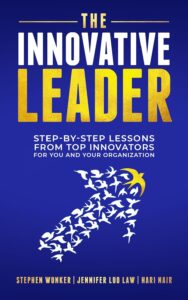
Bill Sherman And you’re like, I got 30 things to do before this plane lands.
Steve Wunker All right. So, no. No choice. I have to listen. You know, I did not really agree to that, but here we are. And this guy went on and on about the car dealerships he owns and the hotels he owns. And there’s clear you have a decent sized business. And he had recently brought in some professor from MIT to lecture to his general managers for a day about innovation. Now, I could have just rolled my eyes and say, oh, well, that’s not going to get you anywhere. But one of the practices we preach in the book is to listen. And so, I listened and I realized, okay. This guy wants to make all these people more innovative without making them professional innovators. He wants to make everybody innovative not only in the outputs of their organization, but in how they manage innovatively. To that they bring innovation to their management style. And, you know, there’s a whole lot more of these guys out there than there are fortune 500 innovation department people. So we need something for this guy.
Bill Sherman Well, and quite literally, by definition, whether you’re talking global 1000, fortune 500, etc., there’s 500 to 1000 odd in audience sense for that, right? Whereas when you say, how do I scale this knowledge for people who need it but may not say, oh, let’s build a center of excellence around innovation, let’s, you know, hire some top talent and really take the time to make its own department. Right. But how do I quit my people to do this better?
Steve Wunker Absolutely. I did a quick check on LinkedIn after that, and I found how many people call themselves innovative leader in their title. It’s over 30,000,
Bill Sherman Which is a large number.
Steve Wunker Yeah, 500 innovation people.
Bill Sherman And with that, it’s a little bit buzzy in terms of buzz word as well. What does that mean. What do you do that’s different. Is there a way or you know, because if I say I am trained in Six Sigma or Lean or Scrum or whatever or agile, I have a sense of what the body of knowledge is with innovative leader. If I just put those as two words in my profile thinking, hey, that’s going to help on, you know, job placement searches again, what does that mean?
Steve Wunker Absolutely. There is a need for a book on the topic when there wasn’t. And moreover, given that my main business is having a consulting firm, there’s more opportunity there for consulting support from experts who have been there, done that many, many times versus people who maybe they needed help when they first started out running a corporate innovation department or, you know, some sort of disruptive innovation incubator. But over after a while, they don’t need that help. They’ve if we’ve done our job decently, they have learned what they need to learn and they can go off and do it.
Bill Sherman The model often for consulting should be the intervention, but it’s not the lifetime move in with the U-Haul truck or the equivalent of pharmaceuticals where you’ll be on this pill the rest of your life, right? We’re not in the pill selling. It’s the problem solving.
Steve Wunker Right? And particularly having a boutique consulting firm that is not our business model. I’ve certainly seen the other side of the coin at big firms, you do want a very long term relationship. But if that existed throughout all of our clients here constantly, then we couldn’t function.
Bill Sherman So let’s jump back to the plane flight for a moment. You’re there in 60 or wherever you are on the plane. You’re hypothetically as a hostage.
Steve Wunker They don’t take account of the conversational quotient. But yes.
Bill Sherman Yeah, yeah, yeah, yeah. Hopefully you got the upgrade on. Right. But so you’re on the flight. When does the epiphany strike you? Is it after the conversation, during the conversation that this should be a book? Let’s dig there for a moment.
Steve Wunker It was about two thirds of the way through, and he had told me about the professor, and I stepped back and I realized, all right, he’s talking about an underlying need here where the professor was not a solve. That was an interesting day, people. High fives. At the end of it, they asked what’s for dinner? And everything reverted to exactly the same way it was beforehand.
Bill Sherman Well, it’s really hard to change the world with keynote anyway.
Steve Wunker That’s right, that’s right. So I started asking him about why and, knowing that I was inviting myself to longer responses and, you know, I heard a little bit about what those motivations were that he really didn’t know what else to do. We thought it would be a good idea. I thought it would be an interesting time. And again I tried to take my own medicine. So Jobs to Be Done is one of my books, and he was basically telling me about his jobs that he was trying to get done, and he happened to hire the professor to do this. But I realized there were much more effective ways to get that job done. Two.
Bill Sherman And that introduces and I want to explore for a moment, and we’ll take a digression here into your story. You mentioned job’s to be done, and I cannot but think of the body of work innovation with Clayton Christiansen, who I know you worked with, but also I know even earlier to that you worked with Fred Reichelt. Net Promoter Score as well. So I’m gonna ask the question broadly, how did you get into the world of thought leadership? Can you share a little bit of that story? Because not everybody gets into the world of thought leadership with some of the marquee names that you did. How did that come to be and what was the experience like?
Steve Wunker I think I was lucky and then enjoyed being in that spot where I was lucky. I started out as a consultant at Bain and Company in the 90s, and I got staff for 50% of my time working with Fred Reichelt, who, as you say, he originated the promoter score. He did a lot of things around the economics of customer loyalty, and I helped him research his second book called Loyalty Rules. And then I worked with being CEO to, research a book called Professional Service Management, too. So I really liked doing that. I knew that wasn’t the only thing I want to do, but I did really enjoy that. And then I also saw, particularly for Fred, how he was able to monetize that for Bain in codifying certain practices, but also really serving as a door opener to new sorts of clients where they might not have had a relationship before. So I ended up years later, working with Clay Christiansen to turn his writings about disruptive innovation into consulting practices and his firm in a site, in Clay being Clay. He kept on writing, and I collaborated with him on a few things. And I really enjoyed doing that. And I saw through that as well just how powerful it can be to distill all this complexity of project work down into a fairly simple narrative, which Clay, by the way, was a master at doing. So, I spun out New Markets Advisors in 2009, and I realized we needed a book to represent the sort of things that we do as a way to distinguish ourselves, as a way to codify it in ways that are replicable. And to show clients here in very concrete terms, is what we do. So, I did that, and that was the first book, and now I’m on the fourth book. So, I guess it’s gone reasonably well. Or I just am very persistent.
Bill Sherman If I think about Frederick Hulk, and I think about Clay Christiansen as well. One of the things that comes to my mind is the clarity of the questions they asked, that they could distill a lot of insight into a powerful question. So the ultimate question in Frederick, too, is will you prefer others write to? And that leads to NPS jobs to be done also echoes that of the no, no, no, no, don’t talk about, you know, a lot of the fluff. Let’s get down to the substance. What does the client or the customer want done. And let’s define that very, very specifically. Right. How, if at all, did working with them influence how you think, and whether as a consultant or as an author in terms of framing thought leadership? And reaching your audience.
Steve Wunker It’s a very interesting question. Fred and Clay, we’re a little different in how they arrived at their theories. Fred was very inductive from the data, looking for the key levers of economic success. He found that customer and employee loyalty, by the way, two were key drivers, and they wanted to find out what were the key determinants of that loyalty. So very classic being let’s start with the data and then work our way up to a theory play. Look for anomalies through observation. He wanted to see things that were surprising. And then he wanted to create circumstance-based theories that explained why this happened. So disruptive innovation was the thing that he first became really known for. But there were many other sources of his doing that as well. Now, intriguingly, once they both settle on their theory, then it was a similar process of okay, let’s find some stories where we can look in-depth at did it really happen this way? And they did the quantitative analysis too. But they really want to understand qualitatively. Is that the whole story? And of course, it’s not the whole story. There’s other things going on too, but. Rather than just rely on data and say, okay, we have this correlation. Therefore, we have causation. They wanted to dig very deep and really understand the workings of the model inside an organization. Did that apply?
Bill Sherman Well. And when I think of Clayton Christiansen, I often think of not only the books but the case studies.
Steve Wunker Right.
Bill Sherman And they’re really in depth. Here’s the problem. Let’s tear it apart and analyze. Right. So you’re on book number four. How did you approach innovative lidar and was it data led? Was it sort of context led? You’re off the plane now, if you will. Right. And you’re drafting. How does this book come to be? And what questions are you asking?
Steve Wunker So I break that into two halves as well. There’s the overall argument of the book, and then there’s the way we went about it. Absolutely. At a very high level, the argument of the book is that innovation is not about inspiration and lightning strikes. It’s about systems. If you have an effective system, you can be innovative both for yourself and for the organization. That I was highly convinced of before. So I knew we were going to be writing about systems, not about just I had this great idea in the shower, and I had some senses about the subjects. I knew culture had to be a subject. I knew we had to have innovation strategy as a subject, but just very high level. What I also realized, though, having worked in a lot of innovative organizations over the years, the virtue of being a consultant, you get to see a lot of those. Is that there are many different styles of innovative leadership. So rather than just saying, well, this is what I think, I should go out and talk to people who are really, really different. And so we surveyed, interviewed 50 top innovative leaders, and they ranged from Satya Nadella, Microsoft or Chip Byrd, the CEO of Levi’s, to people in government to heads of nonprofit or of a school or, entrepreneurial unicorns or even an entrepreneurial dry cleaner that you can be an innovative leader in a lot of different walks of life. So there I was really trying to be inductive. And yeah, I had a set of questions, but I wanted to hear what they said. And let’s distill out some of the things that I may not have thought to put in there. And certainly we got that surface to.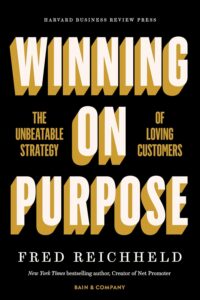
Bill Sherman So on. Building that list of interviewees, right of 50. Some of those are okay. Can I get time on someone’s calendar? Right. Right. But like you said also to an innovative dry cleaner, how do you build that? Is it based on experience and contacts, or did you start building out a list or did you ask for who’s in it? Did you ask for referrals of who? Do you know who’s innovative? Because I think part of that is how do you get that surface of interviews on the right surface becomes essential for a book like this?
Steve Wunker Well, we knew we wanted to be global and we needed a degree of gender balance. And then we didn’t want to just be about large corporations. So there are some that, of course, you’re going to take if you get somebody to offer. Oh, yeah, I get a little bit of time to answer a few questions. Well, yeah, of course I’m going to go for that. Right? Yeah. The dry cleaner, it’s sort of you, you know, when you see it. And it’s an advantage of, again, being a consultant. Do you have a little project with this? We don’t get a lot of dry cleaners calling us up, asking if you could do project work. But here’s a guy who wanted to do something. Had some really grand plans. Spent half a day with him and understood his operation. And he was really rethinking very long held tenets of his industry. And he was being extremely successful doing it. And I realized, all right, this is a guy who has a story, and I don’t care what he does in dry cleaning, it could be anything. He is brought fresh thinking to an industry that hasn’t changed in my lifetime.
Bill Sherman Yeah, I mean, dry cleaning feels like one of the more stagnant ones. Over the course of my life, I remember my dad would go and drop off his dry cleaning, and it’s not that different many times between then and now. Right, when I was a kid.
Bill Sherman If you’re enjoying this episode of Leveraging Thought Leadership, please make sure to subscribe. If you’d like to help spread the word about a podcast, please leave a five-star review at ratethispodcast.com/ltl and share it with your friends. We’re available on Apple Podcasts and on all major listening apps as well as thoughtleadershipleverage.com/podcasts.
Bill Sherman Let’s talk about the book itself. You have a couple different options in that it could be short, light and something easy to digest. And you made a conscious choice in terms of what the experience of the book would be like. And you talked about that with me. So can you describe the book as a book and an artifact in terms of what’s inside?
Steve Wunker That’s right. So let me tell you about the journey through the three other books briefly, because I learned some lessons along the way. So my first book was a super in-depth, researched book about it called Capturing New Markets about 70,000 words. And 12 very interdependent chapters. I was so proud of that book. I’m still proud of that book, but very seldom would people get through all 70,000 words. Even folks who called us up saying, hey, I looked at your book and I’d love you to do some work with us, and you’d use the example from chapter two and that they hadn’t read it. So then the next two books were shorter, about 45,040 thousand words. And that worked. And, they sold more and got read more. But people would also say, well, you didn’t talk about this. You didn’t talk about that. And that is true because you have to do a trade off. When I got to this topic, I knew for one it was very hard to make a short, meaty book because leadership is such a huge topic. There are a lot of different angles, and we want to talk about how very different personalities and contexts people could still be innovative leaders in those contexts. So that created some length to ultimately what we did was we created a narrative first two thirds of the book and a very tabular list, the back third of the book that would serve as a resource to people for years and years and years so far. And we’re still we’re talking here a little bit before publication. The indicators have gone from people looking pre-publication is that they really like that. They like the readability and these are stability, but then they also like that it is as well a reference book that if they just look up in the index, they have this issue, they can often find an exact match for it. And there’s something that’s an infographic or needed to respond.
Bill Sherman Or a tool or something that they can plot. Right. So it’s almost like the conceptual book, plus the field guide or the toolkit kit bundled in one. That’s right. Yeah.
Steve Wunker And it’s 57,000 words. So it’s not short, but that’s what it was required. It was a lot more work to write than some of the shorter things too, because you had to get all that meat in the back through it and support it with the narrative in the front two thirds. So yeah, I guess be careful what you sign up for, but I do think it’s a better product.
Bill Sherman So as you mentioned, we’re prepublication while recording. Talk to me about book launch and how you intend to get this book out into the world. Because if I go back to your seatmate when you were the ambushing in the conversation, you weren’t necessarily he wasn’t cruising through the airport bookstore looking for a book on innovative leader. How does your audience find this book, and how are you getting it out into the world?
Steve Wunker You are exactly right that they are not looking for the new edition on the shelf of that. So. Back when I was cool, which was many, many years ago. I used to listen to a lot of indie bands, and there’s a lot of great indie music out there that nobody has ever heard of. So that taught me the lesson of to get big, you’ve got to be good, but a lot more people are good than are big. The marketing of what you do is so critical. So for this book, we need to go both broad and deep. We need to go broad in hitting people where they’re at, which is typically social media is what they’re going to be consuming or to get them otherwise, or in, speech events. So keynotes, industry conferences, or perhaps, I give a speech at a corporation and they’re one of the attendees. Great. And then in-depth with podcasts, more in-depth articles, occasionally working papers, maybe some, additional pieces that will follow based on innovative leaders in different walks of life. That’s a way to get people to engage in a much more lengthy, long format sort of way, and really get them engaged. You need to get both. Look at Clay’s. Clay’s first book, The Innovator’s Dilemma, is a fantastic book, and it took two years for that to get popular.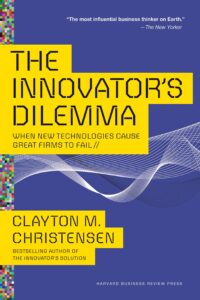
Bill Sherman Absolutely. And that points to one of the things which has been true and continue to be true, that many business books sell more in year two and three to your indie band point than they do in the first 60 or 90 days after launch, right? There’s sort of, momentum that needs to be built where someone says, hey, this is good. Check this out. They tell a friend or the gifted and that sort of thing, whether to a colleague or to their directs, and say, let’s think about it this way. And so you got to stay on message for much longer, I think, than a PR campaign for a book lasts.
Steve Wunker Oh for sure. Right. The PR campaign might be four months and it could take you a year or two. You need to do that whole media mix and do some unglamorous things, right. The indie bands are opening act for some like 80s has been banned maybe, and they can do 2 or 3 songs and that’s it, but they’re out there doing it because, yeah, that’s a way to get out the message.
Bill Sherman And if you’re metaphorically getting your message out by playing the equivalent of a dive bar and you have a small audience, you take those audiences and you keep persistent and passionate with it, because what you don’t know is who’s in the audience and where you’re going to get someone to spark and go, because you’re. And this goes back to loyalty and engagement. Your level of engagement with the content is the ceiling for any audience that you have. So the challenge is just to keep it fresh, not only 90 days, but for two, three, four years, as if you were saying it for the first time.
Steve Wunker Yep. And to get there, by the way, you need to play those dive bars first a little bit. I find with a new speech, I need to do it a good dozen times before I’ve really internalized it. And I can go from thinking about what I’m going to say to looking very closely at what’s working and what doesn’t, fine tuning it, and then having something that can be and replicable. So by the time you’re on the big keynote stage, then you’ve got something which is truly polished.
Bill Sherman Well, and we’re bouncing around on metaphors here from, indie bands. But same thing that a standup comic would do is just do a set at a local club and try out of a few pieces and start building it and say what works for different audiences, and then just really tighten it down piece after piece until you get it under control. And it’s interesting because you would think having written the book, you’d have the mastery of the content, but that’s an entirely different delivery format than it is on stage. Right?
Steve Wunker Well, that’s right. And to be really good at marketing a book or any kind of thought leadership, you have to do something that is very antithetical often to who you are, which is make your very nuanced, beautiful point so darn simple. Yep. The ultimate question. The book that popularized that promoter score was actually Frederick Howard’s third book. His first two books were much more complex and nuanced. And wonderful books, but not remotely as popular as the ultimate question in NPS. So I learned that lesson from Fred. You make it simple. Then people might engage with the other nuanced stuff that you wrote, but you’ve got to have the simple hook.
Bill Sherman And I think of that in terms of Net Promoter Score. I think of it since we’ve been in the world of consulting Trusted Advisor, for example, right, with Green and Master and Young Gal. Right. So there, the ability to distill a very big concept into either a couple of words or an equation, something that you can share in 30s and someone go, that’s interesting. Haven’t thought about it that way. Tell me more. The challenge is to frame it, especially in a noisier world, because when Fred Rykov was writing Ultimate Question, it was a much less noisy world than it is now, right? Now you may have 2 or 3 seconds at most to capture that first. As someone scrolling through social feed, and that’s hard to distill all the nuance, like you said, of your thinking, and you’re like, wow, I’ve dumbed it down to the absolute most reductive possible, but that’s the entry point for a conversation.
Steve Wunker I use the analogy in the book with regard to instilling innovation behaviors of being a little bit like Ronald Reagan, who would say the same three things over and over and over again a limited government, strong defense, traditional values. You could say that one at 40 years after he was president. Yeah. That’s what Reagan stood for.
Bill Sherman Yeah. That’s a brand.
Steve Wunker You need to be Ronald Reagan, the great communicator, and just say the same stuff over and over again until you’re tired of doing it. I’ve not always been so great about that, but I’ve learned that lesson the good way in the hard way as well. Keep it simple and be consistent.
Bill Sherman So we’ve talked about pop launch. Let’s go give you the magic wand. It’s 2 or 3 years from now. If you were to define success both for the book as well as for the idea of the innovative leader, how does landscape change? Because of the.
Steve Wunker So I want this to be a go to resource for the 3000 plus people who think of themselves as innovative leaders or aspiring innovative leaders. And I want the book to be on their bookshelf for years and years to come, because there is a lot of content in there. If that is the case, then commercially the projects will flow. There will be a proportion of people who say, okay, I need help defining our innovation aspiration to revamp or our project review meetings, whatever it might be. There are definitely service offerings in there. That is not a problem. So to get there, I need to be interacting with a broad enough sample of people who will prefer the book to others. And then of course, people actually have to refer. The book has to be good enough to refer the book. So assuming that it is. And so then I work backwards to what does that mean about where I need to be? So I need to be on keynote stages. I need to be giving talks to corporations. I need to have thought short thought pieces on focus topics that are accessible and that circulate broadly around, different, email chains and corporates. So if that’s the end goal, then you sort of work back to what are the strategies you’re going to take to get there.
Bill Sherman And I think that piece on strategy is often one of the things that gets neglected when I see someone go into the book writing process. You know, I’m going to write the book, and then rainbows and unicorns happen after publication, right? And it’s like, not so much, right?
Steve Wunker No, I haven’t seen a whole lot of those. But yeah, you need to think about what’s the end goal for my book, Jobs to Be Done was very different. Clay was coming out with the book on jobs. I had done Clay’s first consulting projects on jobs to be done. And, I chose manuscript, and it was all about why jobs to be done is really important innovation methodology for you to use, but didn’t actually say, here’s how you go deploy it. I wrote the companion book basically that says, here’s how you go deploy it. And my strategy there was for a decent percentage of people who read Clay’s book and say, yeah, that’s great. Now what do I do? Do they pick up my book and they figure out, now what? What do they do? And there are a percentage of those who want professional help and doing it. And here we are. Yep.
Bill Sherman So it’s essentially the companion and field guide again to the theory right. And I think that’s a useful distinction. There is the theory or the knowledge transfer in terms of what’s the issue we’re talking about. What’s the fresh perspective that’s being offered. And then the second step is okay, I’m with you. Whether that took me a chapter or a book to sort of get with you. Now, how do I apply this and give me the resources so that I have the confidence to implement it, or know when I need to raise my hand and get help?
Steve Wunker That’s right. And you need to know what heavy lifting is being done by your book, what heavy lifting might be done by adjunct of resources that are on the book website, for instance, or with your firm, and then, what you need to hire you or your firm or your associates for consulting help to really go make happen.
Bill Sherman So as we begin to wrap up, Steve, I want to ask you a question. You’ve shared your journey of thought, leadership, hope number four on its way, as well as shadowing some of the names in thought leadership who have made a big impact with ideas. Here’s my question for you. Based on what you know today. What advice would you give your younger self to do, either more or less of when it comes to thought leadership?
Steve Wunker Great question. So the number one lesson I’ve learned and probably command this conversation is keep it simple. Yes, you can have all the nuance in the background. You probably should. But keep your core message simple. And then be consistent about repeating that core message. Even if you think your core audience has heard it again and again, keep saying it. That’s I’d say probably the most important one. The second one is more of a business lesson. Which is to know your service offering and construct that core message in a way that dovetails cleanly with your service offering. So people don’t just say, well, that’s a great idea, but they look at chapter three and say, okay, that’s a really neat framework. Now how do I go apply this to my really complex value chain? And here we are. We can help you do that. Which I mean, you try to expose the stuff in a book, but there’s only so far you can go. And for people who have the budget, they’re going to want professional help to actually help get it done.
Bill Sherman We’ve been talking about bands before, and I think a place to close on this is whether it’s your favorite indie band or your favorite classic band, or today, if you go to a concert, you want to hear them play the big songs, right? And that’s the same of if you’re on stage delivering a message, they come to hear the greatest hits, and that’s what they’re looking for. In some ways, might be a little bit of a remix, might be a little bit different perspective, but I love that of staying on message. And don’t be afraid to repeat the big idea. Thank you, Steve.
Steve Wunker You got it. Certainly. George. Talk. Yeah.
Bill Sherman Good luck on the book launch.
Steve Wunker Thanks.
Bill Sherman Okay, you’ve made it to the end of the episode, and that means you’re probably someone deeply interested in thought leadership. Want to learn even more? Here are three recommendations. First, check out the back catalog of our podcast episodes. There are a lot of great conversations with people at the top of their game and thought leadership, as well as just starting out. Second, subscribe to our newsletter that talks about the business of thought leadership. And finally, feel free to reach out to me. My day job is helping people with big insights. Take them to scale through the practice of thought leadership. Maybe you’re looking for strategy, or maybe you want to polish up your ideas or even create new products and offerings. I’d love to chat with you. Thanks for listening.



